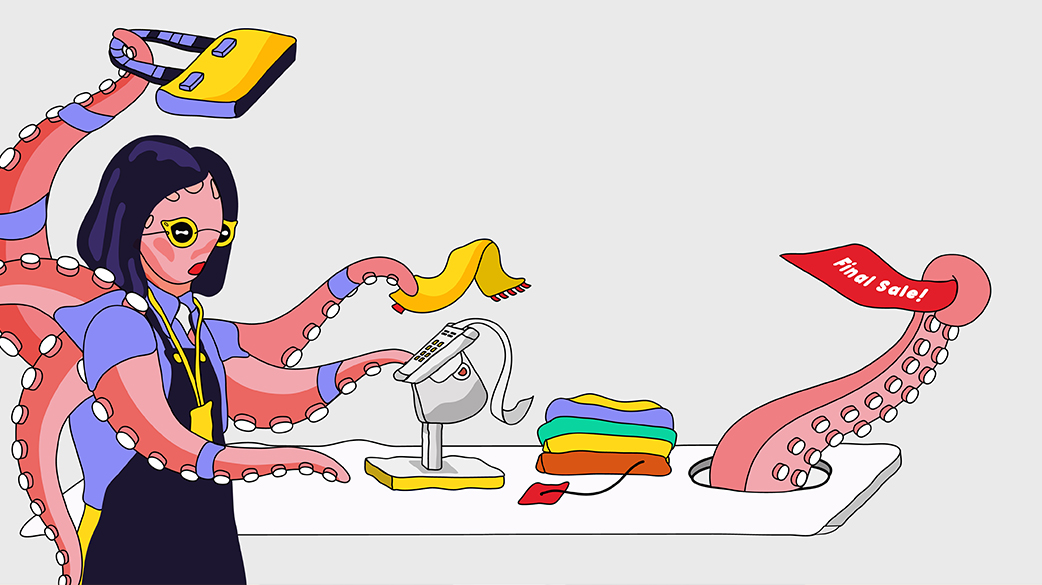Why retail employment plummeted in November

Despite a busy holiday season with record-breaking Black Friday weekend sales, retail was one of the only sectors to post job losses last month in the U.S.
While services such as construction and health care added positions in November, retail lost 30,000 jobs, according to the latest seasonally-adjusted data from the Bureau of Labor Statistics.
Employment in retail has been up and down over the past few months. In August, the sector added 44,000 jobs, while it lost 1,100 jobs in September and gained 7,200 jobs in October.
But demand is still there; even as retail positions plummeted in November, more customers than ever hunted for deals during the stretch between Thanksgiving and Cyber Monday. During those five days, shoppers spent an average of $325 on purchases, according to the National Retail Federation — up from roughly $300 last year. So, what’s going on? Experts say that several factors — including earlier hiring and changes in the workforce at large — are likely at play.
It’s important to note that the losses in retail, along with losses in transportation and warehousing, were outliers in an otherwise-strong jobs report. Overall, the U.S. economy added a larger-than-expected 263,000 jobs last month. Leisure and hospitality and health care saw the biggest gains, at 88,000 jobs and 45,000 jobs, respectively.
‘Pockets of weakness’
The majority of November’s job losses in retail were in general merchandise stores, electronics and appliance stores and furniture and home furnishing stores. These categories “are coming off very high sales levels in 2021, and even the back half of the pandemic in many ways,” Doug Hermanson, principal economist at the global data and consulting firm Kantar, told Modern Retail. Many shoppers already bought these items and don’t need to purchase them again.
“There are some pockets of weakness in retail where they probably don’t need as big of a holiday workforce as they have in the past, just because demand is down,” he said.
One segment of retail that did do well was motor vehicle and parts dealers, according to the BLS. Those companies added 10,000 jobs in November. For many automakers like General Motors, U.S. sales rose in the third quarter, despite interest rate increases and concerns about inflation.
Consumer prices in the U.S. are starting to slow from their decades-high levels. But shoppers might still be spending more of their budgets at this time on necessities like food and gas, Shannon Warner, a partner in consumer practice at the global strategy and consulting firm Kearney, told Modern Retail. “That’s leaving less for other types of retail purchases,” she said.
Earlier hiring
This year, the usual holiday window shifted as more customers bought gifts weeks out to avoid rising prices and take advantage of the most deals possible. To appeal to those spreading out their shopping, companies such as Amazon and Target launched holiday sales as early as October. Retailers moved up their hiring to meet this demand, and “that may change what actually shows up as a small decline,” Hermanson said.
Typically, retailers boost hiring for the holidays to make sure they have enough people on hand to meet the influx of orders. But this year, “retailers are definitely doing seasonal hiring like they have historically, but it’s a lot less volume than what they’ve done,” Warner said. Walmart, for instance, hired 40,000 seasonal workers this year, a far cry from the 150,000 it hired in 2021. Nordstrom hired 20,000 workers, a nearly 9,000 decline from last year.
Many retailers, too, are expecting slower fourth quarters and are mirroring their forecasts in their hiring, Warner pointed out. “They’re lapping really strong comm sales last year. They’re expecting either small, single-digit declines this year, or very modest growth this year over last year. And so, obviously, the employment numbers will follow what they expect their sales forecasts to be.”
A change in the labor force
Companies are also holding onto their existing workforce or changing how they classify workers. Walmart, for instance, announced in 2021 that two-thirds of its hourly associates would become full-time associates by the end of the fiscal year. Target rolled out an app that allows staff members to swap shifts or pick up extra hours.
These types of retailers “have their existing team covering more of the needs, more of the gaps, and so they have less demand for seasonal workers than they had in the past,” Warner said.
Meanwhile, since 2019, “there’s been a real push toward automation and self-service in stores,” Warner said. “That adoption of self-checkout and more automated experiences demands fewer employees to process those sales.” Many grocery stores have adopted technology like scan-and-go, Just Walk Out or smart carts. In some cases, though, this can cause headaches for retailers.
The gig economy is also growing — and people may want a job that allows for more flexibility during the holidays. According to a new survey from the global asset manager Legal & General, 69% of gig workers said they could see themselves working in the gig economy for the foreseeable future. Less than 1 in 10 respondents expressed a desire or plan to leave gig work for a more permanent, traditional method of employment.
“There was so much disruption, in particular, in the labor market this summer,” Aaron Sorensen, partner at Lotis Blue Consulting and head of the firm’s Business Transformation Practice, told Modern Retail. “You saw retailers getting into these wage wars, and talent jumping back and forth and retail workers demanding more pay. I think this volatility caused retailers to… take on a workforce that was probably more than they needed. And they’re now operating a little cautiously.”

